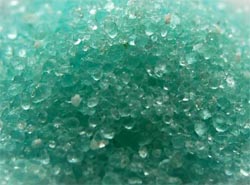Pure copper



Pure copper(Cu) - metal red color, it has a high ductility, i.e. the ability to deform without breaking. Pure copper is a good conductor of current. The conductivity is in third place after gold and silver.
Copper conducts heat very well. It heats up very quickly if contacts with the hot surface, so, not recommended to use for transfer of hot items.
Pure copper is well oxidized. If it long time in the water on surface forms a greenish patina is copper hydroxide Cu(OH)2 and carbonate of copper CuCO3.
Pure copper on the air quickly covered with a thin dark film of copper oxide CuO, that protects it from further damage. Diluted sulphuric acid and copper not react, but concentrated sulfuric acid and the copper easily interact with each other with the formation of a blue solution of copper sulfate CuSO4 (use for spraying trees), toxic sulfur dioxide SO2 and water.
Copper reacts with oxygen. When heated in air, copper products turn black, covered with copper oxide (II) CuO layer. And at a temperature above 1000 °C forms another oxide copper— Cu2O.
If copper is long time in the air, it is covered with a film of malachite, formed by chemical reaction
2Cu+О2+Н2О+СО2=(CuОН)2СО3. This substance gives a color to the bronze monuments and the old roof in Western Europe.
All copper salt are poisonous. Therefore, it is not recommended to use it when cooking or eating. Nitric acid and copper react gradually: first the copper is oxidized to copper oxide, and after it react and forms nitrogen dioxide (NO2), copper nitrate Cu(NO3)2 bluish solution and water. Nitrogen dioxide (NO2) is called “brown gas”. Hydrochloric acid and copper react only when heated. First the copper is oxidized to copper oxide and then forms a greenish copper chloride CuCl2 and water.
The copper sulfate You can use at home: it is a blue crystals, soluble in water. A molecule of copper sulphate contains water (5 water molecules are connected with 1 molecule of copper sulfate). If you heat the blue crystals, we will see that the blue crystals lose their shape and color soon, turning into a crumbly white mass of anhydrous (anhydrous copper sulphate CuSO4).
Copper affects to the color of some minerals, such as malachite (from light blue to dark green color), dioptase (emerald green), etc.
Pure iron
Pure iron (Fe): is silvery white metal, has an amphoteric properties (i.e., can react with acids and alkalis). Iron - heavy metal (1 m3 weighs 7800 kg), has a high plasticity and strength (stronger than copper). Pure iron is a metal with a content of pure iron by weight about 99.995 percent, is almost never used. Speaking about the iron, usually mean its alloys with carbon and other elements: up to 2.14% carbon is steel, more than 2.14% cast irons. In the presence of other elements and change of their concentration in the iron alloy (steel) steels change the physico-mechanical properties.
If the concentration of carbon in the iron alloy exceeds 6,67%, then carbon react (chemical reaction) with the iron and forms not an alloy, but the chemical substance iron with carbide, FeC2.
Pure iron melts at a temperature of 1540 °C, plastic, easy to magnetization. When heated to 768°C, the iron loses its magnetic properties. Pure iron is a chemically active element. Iron and hydrochloric acid react easily and forms ferric chloride, FeCl2. Pure iron is easily oxidized even in moist air, forming the trioxide of iron Fe2 O3*nH2O, otherwise is called rust.
Iron and sulfuric acid reacts with the formation of ferric sulfate Fe(SO4)2, is a transparent greenish solution. If you leave the solution on the air, you will notice after time the formation of brown precipitate is ferrous sulfate combines with the oxygen of the air and forms a friable brown mass of new iron substance: Fe(SO4)3
Nitric acid and pure iron react with the formation of iron nitrate Fe(NO3)2, nitric oxide or NO ammonium nitrate is NH4NO3 (substance known as ammonium fertilizer) and water. So, the typical reaction dilute acids with iron. Concentrated nitric and sulphuric acid do not reacrt with pure iron (at room temperature), due to the presence of oxide film.
Iron displaces copper easily in chemical substitution reactions, if in solution of copper sulphate to put the iron metal product. We will observe on the surface of iron the formation of microscopic crystals of chemically pure copper red-brown color. And blue copper sulphate solution gradually fades and becomes greenish, due to the formation of ferrous sulfate FeSO4x5H2O. But this method is not effective for solid copper coatings. For higher quality coating of copper is used electricity. In this way ( substitution reaction) any metal can be covered with copper, that stand left of copper in a number of strains of metals. But it must be remembered if it has a deep scratches on the coating surface, can be formed galvanic element (if the system is in the electrolyte), that leads to the destruction of metals.
Pure iron gives color to some minerals: hematite (grey-to-dark color), Topaz (colorless, blue, lightblue, yellow, orange).
The most important chemical substances of iron are:
FeSO4x5H2O - iron sulfate - is used in agriculture as a poison for pest control;
Fe2(SO4)3x9H2O - water sulfate used to purify water;
FeCl3 is also used for water purification, and also for etching of copper (electronics)
Fe(NO3)2x9H2O - water nitrate of iron is used in textile industry for processing and painting fabric
As to pure iron, it is used mainly as a catalyst in chemical reactions.
theTo determine the presence of ions of iron (2-or 3-valent) can due to qualitative reactions
Iron forms 3 different iron oxide, differing in the degree of iron oxidation, the color of chemical substances and its activity.